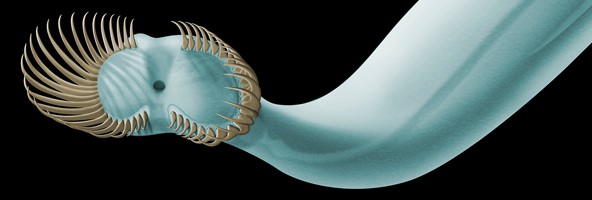Royal Ontario Museum and Yale University researchers name new species of arrow worm from the Cambrian Period
TORONTO, Aug. 3, 2017 – Scientists have identified a small marine predator that once patrolled the ocean floor and grabbed its prey with 50 spines that it deployed from its head.
Named Capinatator praetermissus, this ancient creature is roughly ten centimeters long and represents a new genus and species. It is related to species that are found in present-day plankton. Scientists from the Royal Ontario Museum and Yale University made the identification based on 50 specimens from the fossil-rich Burgess Shale in British Columbia.
“This is the most significant fossil discovery about the chaetognath group of animals to date,” says Derek Briggs, Yale’s G. Evelyn Hutchinson Professor of Geology and Geophysics and curator at the Yale Peabody Museum of Natural History. Briggs is lead author along with co-author Dr. Jean-Bernard Caron of a study published in Current Biology about this discovery.
Jean-Bernard Caron, Senior Curator of Invertebrate Palaeontology at the Royal Ontario Museum and an Associate Professor in the Departments of Ecology & Evolutionary Biology and Earth Sciences at University of Toronto, says: “This new species would have been an efficient predator and a terrifying sight to many of the smallest marine creatures that lived during that time.”
Chaetognaths are small, swimming marine carnivores that are also known as arrow worms. They are known from about 120 species today and represent a separate phylum of animals. Capinatator is one of the largest chaetognaths known, living or fossil. At more than 500 million years old, Capinatator is thought to be a forerunner of the smaller chaetognaths that are abundant in today’s oceans, where they make up a large portion of the world’s plankton and the ocean food chain.
According to the researchers, Capinatator’s head configuration is unique. With about 25 spines in each side of its head, the species has nearly double the maximum number of spines found in today’s chaetognaths. This enabled Capinatator to capture prey by closing the two halves of its grasping spines toward each other as it swam.
Briggs and Caron also determined that while it is fairly common to find evidence of chaetognath spines, fossilized chaetognath bodies are extraordinarily rare. Many of the Capinatator specimens in this study included evidence of soft tissues.
“These Burgess Shale fossil specimens preserve evidence of features such as the gut and muscles, which normally decay away, as well as the more decay-resistant grasping spines,” says Briggs. “They show that chaetognath predators evolved during the explosion of marine diversity during the Cambrian Period, and were an important component of some of the earliest marine ecosystems.”
The species name “praetermissus” means “overlooked”. The name Capinatator is derived from “capio,” which means “to grasp,” and “natator,” which means “swimmer.”

The material for this study was collected by the Royal Ontario Museum under various research and collecting permits delivered by Parks Canada and is held in the Museum’s collections. The Burgess Shale fossil sites are located within Yoho and Kootenay National Parks. Parks Canada protects the sites and works with leading scientific researchers to expand knowledge and understanding of this key period of earth history. The Burgess Shale was designated a UNESCO World Heritage Site in 1980.
Research funding was provided by the NASA Astrobiology Institute, a Natural Sciences and Engineering Research Council Discovery Grant, a Peer Review grant from the ROM Reproductions Fund, and a grant from the Louise Hawley Stone Charitable Trust Publications Fund.
Full Reference:
A large Cambrian chaetognath with supernumerary grasping spines
Derek E.G. Briggs, G. Evelyn Hutchinson Professor of Geology and Geophysics Curator, Yale Peabody Museum of Natural History, and Jean-Bernard Caron Senior Curator of Invertebrate Palaeontology, Royal Ontario Museum, Current Biology
DOI# 10.1016/j.cub.2017.07.003
